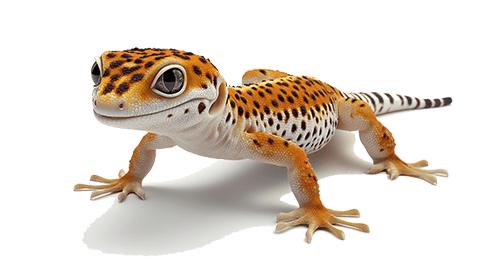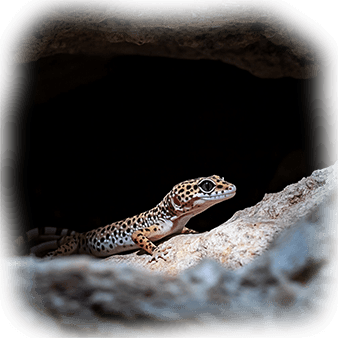Leopard Geckos as Pets – The Ultimate Beginner-Friendly Reptile

Leopard geckos are one of the most popular reptiles kept as pets, and for good reason! These little lizards are not only easy to care for but are also full of personality and charm. If you’re looking for a low-maintenance, fascinating pet, a leopard gecko might be just what you need.
What Makes Leopard Geckos Special? Leopard geckos are native to the dry, rocky deserts of Afghanistan, Pakistan, India, and Iran. Their distinctive spotted pattern gives them their name, resembling the wild leopard. These geckos are known for their relatively calm temperament, small size (typically around 7-10 inches long), and long lifespan—many live 10 to 20 years with proper care!

Nocturnal Nature – Sleeping and Activity Patterns Leopard geckos are crepuscular, meaning they are most active during the dawn and dusk hours. You won’t see them out and about much during the day, as they prefer to sleep and rest in cool, dark hiding spots. Their sleeping habits align with their natural desert environment, where it’s safer to hide from the sun and predators. Don’t be surprised if you catch your gecko napping under a log or in a small cave during daylight hours.

Feeding Your Leopard Gecko – What’s on the Menu? Leopard geckos are insectivores—they eat insects exclusively. Some of their favorite meals include crickets, mealworms, and dubia roaches. A good rule of thumb is to feed them a couple of times a week, offering food that’s no bigger than the width of their head. These little guys also need their insects dusted with calcium powder to keep their bones healthy—this prevents metabolic bone disease, which can be common in reptiles if they don’t get enough calcium.
One interesting thing about leopard geckos is their tail—they store fat in their tail, which acts as a food reserve. If your gecko ever goes a little longer without food (though this shouldn’t happen often), they can survive off the fat in their tail. A thick, healthy tail is a sign of a well-fed and happy gecko.

Hydration – They Don’t Drink Much! Leopard geckos get most of their water from their food, but they still need access to fresh water daily. A shallow water dish in their habitat should do the trick. Keep it clean to avoid bacteria buildup, and make sure it’s not too deep, as they aren’t strong swimmers.

Their Relationship with Humans – Calm and Curious Leopard geckos are known for being friendly, especially compared to other reptiles. While they might be shy at first, they often warm up to their owners with regular handling. One great thing about leopard geckos is that they rarely bite, and even if they do, it’s usually a gentle nibble. They’re great for people new to handling reptiles since they’re generally calm and don’t mind being picked up.
However, always be gentle—leopard geckos have delicate skin and bones, and too much rough handling can cause injury. When they trust you, you might notice them crawling onto your hand willingly and even looking up at you curiously with their big, expressive eyes.

What Do Leopard Geckos Like?
- Warmth – Since they are cold-blooded, leopard geckos rely on external heat sources to regulate their body temperature. A heating pad or heat lamp in their enclosure is crucial. They like to have a warm side (around 90°F) and a cool side (around 75°F) so they can thermoregulate.
- Hiding Spots – They love to hide! Their natural instinct is to find places where they can feel safe and secure, so provide plenty of small caves, hides, and logs in their enclosure.
- Climbing – While they aren’t as adept at climbing as other reptiles, they do enjoy a bit of vertical exploration. A few rocks or ledges in their enclosure can keep them happy.

Interesting Facts about Leopard Geckos
- They Shed Their Skin Regularly – Like many reptiles, leopard geckos shed their skin frequently, especially when they’re young and growing. You’ll notice the color of your gecko becoming dull just before shedding. What’s really cool is that they often eat their shed skin—this is thought to help them absorb nutrients and avoid attracting predators.
- They Can Drop Their Tail – If threatened, leopard geckos can drop their tail as a defense mechanism. Don’t worry, it grows back, but it’s a stressful event for them and takes time to heal.
- Quiet Pets – Unlike some pets, leopard geckos don’t make much noise. Occasionally, they may make a small chirping sound if they’re excited or stressed, but for the most part, they’re silent, making them ideal for apartment dwellers.

Housing and Enclosure Setup Setting up the right enclosure is key to keeping your leopard gecko happy. A 20-gallon tank is a good size for one gecko. Line the bottom with paper towels, reptile carpet, or slate tiles—avoid loose substrates like sand, as they can cause impaction if ingested. You’ll also need:
- A heat source for thermoregulation (under-tank heater or a heat lamp)
- Hides for sleeping and security (at least one on the warm side and one on the cool side)
- A shallow water dish
- A humid hide filled with damp moss or paper towels to help with shedding
- Rocks, branches, or other items for some light climbing

Final Thoughts – Why Leopard Geckos Make Great Pets Leopard geckos are perfect for beginner reptile keepers thanks to their easy-going nature and simple care requirements. They’re fun to watch, easy to feed, and can even form a bond with their owner. Whether you’re new to reptiles or just want a low-maintenance pet, a leopard gecko can be a fantastic companion that brings a little piece of the wild desert into your home.
Their quiet nature, fascinating habits, and adorable looks make them a top choice for pet enthusiasts. With the right care, you’ll have a happy, healthy gecko friend for years to come!
Further reading: “The Complete Guide to Leopard Gecko Care and Ownership: Covering Morphs, Vivariums, Substrates, Handling, Feeding, Bonding, Shedding, Tail Loss, Breeding, and Health Care Paperback” (Amazon affiliate link) by Samantha Slevens.
Affiliate Disclosure
This post may contain affiliate links, which means I earn from purchases made through links. Please see the privacy policy page for more details.






